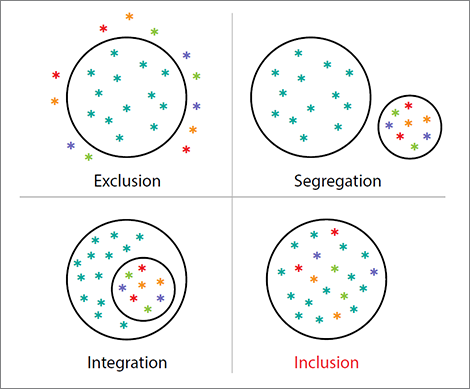Inclusion in education is all about equal access for all students to education, regardless of their background or learning style. By making it easier for students to participate in learning opportunities, schools can encourage friendships and foster better communication. Read on to learn more about what inclusion in education means and how to promote it in your school. This article focuses on the benefits of inclusion. It may surprise you to learn that it is much easier than you might think.
Inclusive classrooms are filled with diverse learners
The best way to create an inclusive classroom is to make sure that students from different backgrounds participate and learn together. Often, students with and without special needs share a classmate, making it easier for them to build friendships and respect one another. In addition, an inclusive classroom environment helps non-disabled students to develop social skills. By creating a supportive and respectful environment, students can be more confident in their abilities.
Inclusion models include teachers with different backgrounds, special education students, and general education students working together. These teachers deliver the same lesson to all students, but they differentiate for the students with disabilities. Some schools use a co-teaching model, which involves the special education teacher working alongside the general education teacher to help the students with their specific needs. In addition to co-teaching, some schools also use a hybrid model, in which a general education teacher pushes in to help the students with disabilities. This allows students to receive individualized support and attention, while also ensuring that general education students have access to the same educational environment.
Inclusive schools are willing to innovate
Inclusion starts in the classroom, where teachers know their students well and celebrate diversity. This mindset fosters a sense of acceptance and respect for all students. Inclusion requires specific strategies, and a shift in school culture. While the Education for All Handicapped Children Act (EACCH) provided a foundation for inclusive education, the Act left open the question of what education for disabled children should be like. The Individuals with Disabilities in Education Act (IDEA) outlines what an inclusive school should be like.
The Digital Promise center is currently designing an inclusive innovation model for scale. Researchers from the center describe five stages of the inclusive innovation process. These stages include connecting, investigating, designing, implementing, and iterating. Ultimately, inclusive innovation is a continuous process that takes time and patience. However, school leaders need to make sure that they support innovation. Here are some examples of ways educators can promote innovation in inclusive schools:
Inclusive classrooms promote friendships
To build an inclusive classroom, students must feel they belong and are part of a group. Friendships create a sense of belonging and stability, two critical factors in learning and developing social skills. In addition, recent neuroscience research has demonstrated that friendships foster openness to new concepts. These are just some of the many benefits of inclusive classrooms. To understand more about the benefits of inclusive classrooms, read on.
One example of the positive effects of inclusive classrooms on students’ social skills is that children can use the whiteboard to write, erase, and move images on the board. Some interactive whiteboards even turn student work into videos! Inclusive classrooms promote friendships in education because they are made up of a mix of students with different learning styles and backgrounds. Having a best friend makes it easier for students with problem behaviors to gain acceptance from peers.
Inclusive classrooms improve communication
There are many reasons to implement inclusive classroom practices. For one, it improves communication among students. Inclusive teachers show positive attitudes toward their students and their families. In addition, they ensure that the curriculum materials reflect a range of cultures. Secondly, they use instructional strategies that allow students to learn in their first language, while promoting English-language development. Finally, they use strategies to increase student choice, while acknowledging implicit bias.
Another reason to adopt an inclusive classroom approach is to increase the level of student interaction. This way, students with different abilities and learning styles can interact with each other, while all students can access the same curriculum. Despite this, teachers should still differentiate lessons to meet the needs of individual students. This way, they can maximize the learning environment and help all students achieve their full potential. And while not all schools support a cultural shift, they can make an impact on their classrooms.
Inclusive classrooms encourage refined social skills
Inclusive classrooms have many benefits, but what are the key elements to ensure a truly inclusive learning environment? Several factors may be responsible, including teacher training, inclusion policies, and inclusive classroom practices. In addition to providing the necessary resources, these environments promote students’ social development and reinforce a range of values. Here are some ways that inclusive classrooms can help students develop refined social skills:
Teachers should lead by example. This is a vitally important aspect of an inclusive classroom because their behavior sets the tone for the students’ interactions. By modeling a welcoming attitude, teachers can help students learn how to respect other students’ needs and views. This will result in more respect and tolerance. And, in a world where differences can be celebrated, inclusive classrooms encourage refined social skills in students. Inclusion can be encouraged with a few simple classroom modifications.

